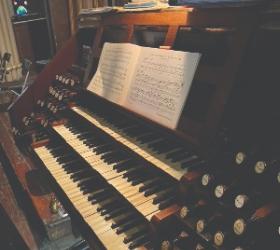
Schoenstein & Co., San Francisco, California
TMI – The Episcopal School of Texas, San Antonio, Texas
The Anatomy of an Installation
The installation of a new organ is a time of mystery for many clients. Although we have provided much information and site preparation details, when the delivery day actually arrives there is usually surprise expressed at the giant pile of material that now fills their entire church. Once the unloading is completed, the next question is “How will we have worship on Sunday with all of this stuff in the way?” I answer, “Most of it will be in by the weekend!,” but they seldom believe me. As Sunday approaches and church members begin to see the pews and floor revealed once more, the easy-to-see progress of installing large components causes a contradictory view: church members now believe the new organ will completed very soon, since the assembly has been so swift. After realizing that the intricate work of winding, wiring, and tonal finishing is yet to be completed, they eagerly wait to hear the first sounds of their new instrument.
The straightforward nature of the installation at the TMI Chapel is a perfect venue to demonstrate the process of an organ installation. From the main floor of the chapel that was cleared for the arrival of the organ parts through the completion of the organ, these pictures will walk you through the day-by-day process of installing a pipe organ.
—Louis Patterson
Vice President and
Plant Superintendent
Photo credit: Louis Patterson
Duty, Honor, Country
The TMI Legacy
Taking part in building an organ for General Douglas MacArthur’s Alma Mater had a special meaning for me. To those of us on the West Coast, the war in the Pacific seemed to be very close to home. Even as a small boy, I remember the pervasive talk of possible attack. Submarines were sighted, gas masks issued, blackouts ordered—all both fascinating and frightening. Spirits were lifted with constant talk of victory. I remember even cutting out a paper “V” for our Christmas tree! All hopes were pinned on our hero of the Pacific, General of the Army, Douglas MacArthur. The General always gave credit for both his career and his faith to the classical education, discipline, and daily chapel services of The Texas Military Institute, which he entered in 1893 at age 13.
The General did bring us victory and then served through the occupation and again in Korea with brilliance and dedication. In 1951, when he returned home, I remember going with my mother to the City and joining my father to watch from his office window as MacArthur came up California Street in a huge Packard touring car amid what was the most spectacular ticker tape parade in San Francisco history. He represented the forces under his command who saved us. At the time it was an exciting event. In memory, it is very moving.
Most of us know of MacArthur’s famous “Duty, Honor, Country” and “Old Soldiers” speeches, but I would like to quote from the first radio speech given right after V-J Day, for it is especially appropriate as we dedicate this organ to his memory, with the hope that its music will help in forming a foundation of faith for future leaders.
Today the guns are silent. A great tragedy has ended. A great victory has been won. . . . The entire world is quietly at
peace. . . Man since the beginning of time has sought peace, (but) military alliances, balances of power, leagues of nations, all in turn failed, leaving the only path to be by way of the crucible of war. . . . If we do not now devise some greater and more equitable system, Armageddon will be at our door. The problem basically is theological and involves a spiritual recrudescence and improvement of human character that will synchronize with our almost matchless advances in science, art, literature and all material and cultural developments of the past two thousand years. It must be of the spirit if we are to save the flesh.
Tonal Design Notes
The TMI tonal design contains all of the elements that we feel are absolutely necessary in a moderate-sized church organ—an instrument affordable by the average church that is serious about its music. I hasten to point out that this is not a symphonic organ—and purposely so. The dynamic and color range of a symphonic organ is a marvelous advantage, especially for intricate or transcribed accompaniments, large-scale Romantic repertoire, orchestral transcriptions, and improvisations. However, for many music programs a more traditional approach is not only fully adequate, but preferred. This stoplist is based on a survey of TMI’s specific musical requirements, which match those of many mainline churches.
Here are the 10 design points that, in our system, must be represented in a church organ of this size:
1. Great and Swell equally balanced in power, with the two primary elements of tonal power, diapason and trumpet, disposed opposite one another for contrast. Usually diapason tone is dominant in the Great, trumpet tone under expression in the Swell.
2. Variety of diapason tone. Although not dominant, diapason tone must not be overlooked in the Swell. In this organ, the Swell Horn Diapason is distinctly different from the Great Open, being of narrow mouth and slotted construction. This organ has the luxury of an independent Pedal Open Diapason as well. The Great includes a chorus of 4′ Principal, 2′ Fifteenth and 11⁄3′ Mixture, all under expression. The complementary upperwork for the Swell Horn Diapason is the 4′ Gemshorn, which is a mildly tapered principal, extended 12 pipes to form a Fifteenth.
3. Variety of reed tone. In addition to a conical chorus stop (trumpet), a double taper color stop (oboe) and a cylindrical color stop (clarinet) should be included to provide the three major reed qualities most often needed in church work.
4. True string and celeste tone. Genuine strings scaled narrow enough to give a “rosin on the bow” effect are a vital and often neglected element of tonal contrast to the wider-scaled diapasons and flutes.
5. A contrasting ethereal voice with celeste. In this case we selected our very strongly tapered Corno Dolce, which is a hybrid stop in that mysterious tonal ground between flute and string. Maximum use is assured when these stops are placed opposite the strings in an expressive Great.
6. Stopped and semi-open flutes of contrasting tone. This organ has a stopped metal flute, a stopped wood flute, and a very narrow-scaled chimney flute that is much like the traditional German and English Lieblich Gedeckts.
7. An open flute of solo quality. A moderate-scale Harmonic Flute was chosen; being in a prominent position outside the expression box, it is capable of balancing with full accompaniments and can stand up to the Trumpet.
8. A robust Pedal with 16′ stops from each major tonal family. This organ includes a large-scale open stop of wood, a small-scale open stop of metal, a stopped wood flute, and a full-length trumpet.
9. Independent expression for the Swell and Great, with only major foundational and solo stops unexpressive. Unenclosed stops on a small organ are a luxury.
10. Full coupling and careful use of unification. These devices are to be used with discretion by the organist to increase musical flexibility. This organ includes a Great to Swell coupler so that all enclosed stops may be played against the future unenclosed, high pressure Grand Trumpet.
—Jack M. Bethards
TMI – The Episcopal School of Texas
San Antonio, Texas
Two manuals and pedal
18 voices, 20 ranks
Electric-pneumatic action
GREAT (expressive – 4″ wind)
16′ Corno Dolce 12 pipes
8′ Open Diapason† 61 pipes
8′ Harmonic Flute† 61 pipes
8′ Gedeckt 61 pipes
8′ Corno Dolce 61 pipes
8′ Flute Celeste (TC) 49 pipes
4′ Principal 61 pipes
4′ Gedeckt 12 pipes
4′ Corno Dolce 12 pipes
2′ Fifteenth 61 pipes
11⁄3′ Mixture (II–III) 145 pipes
8′ Clarinet 61 pipes
Tremulant
Great Unison Off (enclosed stops only)
8′ Grand Trumpet (prepared)
†In Display
SWELL (expressive – 4″ wind)
16′ Bourdon 12 pipes
8′ Horn Diapason 61 pipes
8′ Stopped Diapason 61 pipes
8′ Echo Gamba 61 pipes
8′ Vox Celeste (TC) 49 pipes
4′ Gemshorn 61 pipes
4′ Chimney Flute 61 pipes
22⁄3′ Nazard (from Chimney Flute)
2′ Fifteenth (ext. Gems) 12 pipes
16′ Bass Trumpet 12 pipes
8’ Trumpet 61 pipes
8′ Oboe Horn 61 pipes
Tremulant
Swell 16′
Swell Unison Off
Swell 4′
8′ Grand Trumpet (prepared)
PEDAL (4″ wind)
16′ Open Diapason (Wood)† 12 pipes
16′ Corno Dolce (Great)
16′ Bourdon (Swell)
8′ Principal (Metal)† 32 pipes
8′ Diapason (Swell)
8′ Flute (Great)
8′ Stopped Diapason (Swell)
8′ Corno Dolce (Great)
4′ Fifteenth† 12 pipes
4′ Flute (Great)
16′ Bass Trumpet (Swell)
8′ Trumpet (Swell)
4′ Clarinet (Great)
†In Display
Couplers
Great to Pedal
Great to Pedal 4′
Swell to Pedal
Swell to Pedal 4′
Swell to Great 16′
Swell to Great
Swell to Great 4′
Great to Swell (enclosed stops only)
Mechanicals
Solid State Capture Action with:
100 memories
38 pistons and toe studs
6 reversibles
Record/Playback
Transposer
Sequencer
2 Expression pedals




